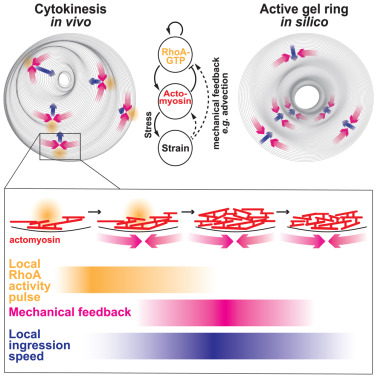Mechanical and biochemical feedback combine to generate complex contractile oscillations in cytokinesis https://doi.org/10.1016/j.cub.2024.06.037
The actomyosin cortex is an active material that generates force to drive shape changes via cytoskeletal remodeling. Cytokinesis is the essential cell division event during which a cortical actomyosin ring closes to separate two daughter cells. Our active gel theory predicted that actomyosin systems controlled by a biochemical oscillator and experiencing mechanical strain would exhibit complex spatiotemporal behavior. To test whether active materials in vivo exhibit spatiotemporally complex kinetics, we imaged the C. elegans embryo with unprecedented temporal resolution and discovered that sections of the cytokinetic cortex undergo periodic phases of acceleration and deceleration. Contractile oscillations exhibited a range of periodicities, including those much longer periods than the timescale of RhoA pulses, which was shorter in cytokinesis than in any other biological context. Modifying mechanical feedback in vivo or in silico revealed that the period of contractile oscillation is prolonged as a function of the intensity of mechanical feedback. Fast local ring ingression occurs where speed oscillations have long periods, likely due to increased local stresses and, therefore, mechanical feedback. Fast ingression also occurs where material turnover is high, in vivo and in silico. We propose that downstream of initiation by pulsed RhoA activity, mechanical feedback, including but not limited to material advection, extends the timescale of contractility beyond that of biochemical input and, therefore, makes it robust to fluctuations in activation. Circumferential propagation of contractility likely allows for sustained contractility despite cytoskeletal remodeling necessary to recover from compaction. Thus, like biochemical feedback, mechanical feedback affords active materials responsiveness and robustness.
